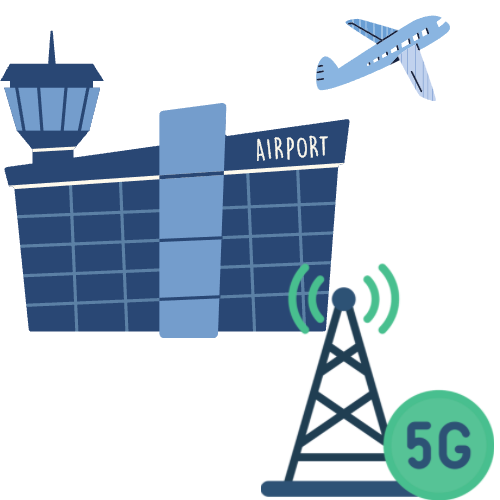
Today is finally the day that Verizon is rolling out their 5G Ultra Wideband (5G UWB) network. Buffer zones around 50 airports have been enabled in preparation. This comes after much back and forth consulting, and arguing, between the FAA, the FCC, AT&T, and Verizon.
While things seem to have settled down between the companies, tensions at airports are quite high as some flights are being delayed or canceled with fear of potential risks. This is because of the closeness between the frequencies 5G is running on – what’s called the C-Band spectrum – and the frequencies used in aircrafts. There have been concerns of interference risks with aircraft landing tools – specifically the airplane’s altimeter, which helps the pilot verify distance between the plane and the ground. This is mainly beneficial in situations where the weather is poor and tools are needed to help the pilots land safely.
AT&T, who also agreed to delay and limit their 5G rollout, on the same C-Band spectrum, commented recently.
“At our sole discretion we have voluntarily agreed to temporarily defer turning on a limited number of towers around certain airport runways as we continue to work with the aviation industry and the FAA to provide further information about our 5G deployment,” AT&T said in a statement Tuesday.
Verizon followed AT&T saying, “We have voluntarily decided to limit our 5G network around airports. The Federal Aviation Administration (FAA) and our nation’s airlines have not been able to fully resolve navigating 5G around airports, despite it being safe and fully operational in more than 40 other countries.”
CEOs from American, United, Delta and seven other major carriers also warned of “significant” disruptions in the country’s aviation system if the 5G rollout continued as planned.
In a letter, U.S. airline leaders wrote to government officials Monday asking that the wireless carriers not deploy 5G within two miles of runways at certain airports.
“This will allow 5G to be deployed while avoiding harmful impacts on the aviation industry, traveling public, supply chain, vaccine distribution, our workforce and broader economy,” the CEOs wrote.
The FAA warned pilots won’t be able to use radio altimeters to land at 88 airports closest to Verizon and AT&T’s 5G towers. Earlier this month, the FAA and wireless carriers agreed to implement “buffer zones” around 50 airports across the country to try to mitigate the issue.
Airline officials, however, said this is not enough. United Airlines said the current plan will have “devastating” impacts on its operation, impacting an estimated 1.25 million of the carrier’s passengers and at least 15,000 flights.
“We won’t compromise on safety – full stop,” United said in a statement.
Captain Dennis Tajer, an American Airlines 737 pilot and a spokesperson for the Allied Pilots Association, also called the rollout “unsafe.”
“We’re not going to fly the airplane unless it’s safe,” Tajer told ABC News. “But putting that added distraction of other systems going wrong close to the ground is not the way you run a safety culture.”
AT&T and Verizon have been touting that the 5G C-Band spectrum has been proven safe in about 40 other countries. However, what is generally missed, is the fact that the power of the 5G signals in these other countries is much lower than what we have planned here in the United States. With this increased power and unknowns surrounding how aircrafts will be affected, it’s clear why the FAA is so concerned.
In a statement, AT&T made clear its frustration with the federal government, writing in part: “We are frustrated by the FAA’s inability to do what nearly 40 countries have done, which is to safely deploy 5G technology without disrupting aviation services, and we urge it do so in a timely manner. We are launching our advanced 5G services everywhere else as planned with the temporary exception of this limited number of towers.”
When asked why the FAA did not act over the past two years, White House press secretary Jen Psaki said, “There will be lots of time to look back and see how we got here. And I know many of you will do that. And, of course, that is understandable. But right now, over the next 24, or less than 24 hours, what we’re focused on is trying to come to a solution that will minimize travel — you know disruptions to passenger travel, cargo operations — on our economic recovery.”
President Biden thanked Verizon and AT&T for the delay, saying in a statement, “This agreement will avoid potentially devastating disruptions to passenger travel, cargo operations, and our economic recovery, while allowing more than 90 percent of wireless tower deployment to occur as scheduled.”
The president said the agreement “protects flight safety and allows aviation operations to continue without significant disruption and will bring more high-speed internet options to millions of Americans.”



